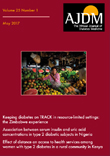Understanding the Contrast: Type 1 Diabetes vs. Type 2 Diabetes
*Corresponding Author:
Received: 01-Apr-2024, Manuscript No. ajdm-24-129828; Editor assigned: 03-Apr-2024, Pre QC No. ajdm-24-129828 (PQ); Reviewed: 17-Apr-2024, QC No. ajdm-24-129828; Revised: 22-Apr-2024, Manuscript No. ajdm-24-129828(R); Published: 29-Apr-2024, DOI: 10.54931/AJDM-32.2.18.
Introduction
Diabetes, a chronic metabolic disorder, manifests in various forms, with Type 1 and Type 2 being the most prevalent. Despite sharing the same name, they differ significantly in their underlying causes, onset, treatment, and management. Understanding these differences is crucial for effective management and prevention strategies. Let’s delve into the distinctive characteristics of Type 1 and Type 2 diabetes.
Description
Type 1 diabetes, often diagnosed in childhood or adolescence, results from the body’s immune system attacking insulinproducing beta cells in the pancreas. This autoimmune response leads to little to no insulin production, necessitating lifelong insulin therapy. In contrast, Type 2 diabetes typically develops in adulthood, although its prevalence in children is increasing due to rising obesity rates. It stems from insulin resistance, where the body’s cells become less responsive to insulin’s actions, coupled with decreased insulin production over time. Individuals with Type 1 diabetes are entirely dependent on exogenous insulin to regulate blood sugar levels. Without insulin injections or infusion through an insulin pump, blood glucose levels can rise dangerously high, leading to diabetic ketoacidosis—a life-threatening condition. Type 2 diabetes initially responds to lifestyle modifications, such as dietary changes, exercise, and oral medications to improve insulin sensitivity or stimulate insulin production. However, as the condition progresses, some individuals may require insulin therapy to manage their blood sugar effectively. The onset of symptoms in Type 1 diabetes is often abrupt and severe, including excessive thirst, frequent urination, unexplained weight loss, fatigue, and blurred vision. These symptoms develop rapidly over a short period, prompting immediate medical attention. Conversely, Type 2 diabetes symptoms may be subtle and develop gradually over years, making early detection challenging. Common symptoms include increased thirst, frequent urination, fatigue, blurred vision, slow wound healing, and recurrent infections. Type 1 diabetes has a stronger genetic component, with certain genes increasing susceptibility to autoimmune destruction of pancreatic beta cells. However, environmental triggers, such as viral infections, may also play a role in triggering the autoimmune response. While genetics contribute to Type 2 diabetes risk, lifestyle factors, such as obesity, sedentary behavior, poor dietary choices, and aging, play a more significant role in its development. Family history of Type 2 diabetes can increase the likelihood of developing the condition, but it is not solely deterministic. Preventing Type 1 diabetes is currently not feasible due to its autoimmune nature. However, ongoing research focuses on understanding the triggers and developing strategies for early intervention or immunomodulation to delay or prevent its onset. Type 2 diabetes prevention primarily revolves around lifestyle modifications, such as maintaining a healthy weight, engaging in regular physical activity, and adopting a balanced diet rich in fruits, vegetables, and whole grains. Early diagnosis through regular screenings enables timely intervention to prevent or delay complications.
Conclusion
In summary, while both Type 1 and Type 2 diabetes share the commonality of affecting blood sugar regulation, they differ significantly in their etiology, onset, treatment, and prevention strategies. Recognizing these distinctions is essential for targeted interventions, personalized management plans, and empowering individuals to lead healthier lives. Whether through advances in medical research, lifestyle modifications, or community awareness, addressing the complexities of diabetes remains paramount in improving global health outcomes.





